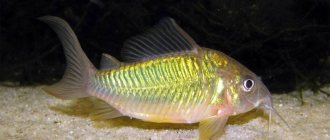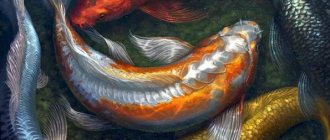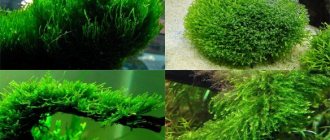Brazilian lileopsis (Lilaeopsis brasiliensis) is an aquatic grass of the umbrella family. There are 9 varieties of this perennial herbaceous plant; they are similar in morphological characteristics. Many aquarists plant this crop as a decoration for the water space in the aquarium, and it also serves as a shelter for many fish and arthropod inhabitants.
Brazilian lileopsis (Lilaeopsis brasiliensis) is an aquatic grass of the umbrella family.
Growing and care
Lileopsis is grown to decorate aquariums in the form of a lawn placed in the foreground. Optimal conditions for this plant are provided in a paludarium, where the root part is in water and the leaf part is in the air. In such conditions, lileopsis grows faster than under water (in an aquarium).
During the growth process, individual leaves dry out and turn yellow, so the “lawn” requires periodic pruning and thinning. In addition, shoots that rise above the general mass should also be cut off. In an aquarium, lileopsis can become overgrown with algae, so it needs periodic thinning.
Some aquarists grow lileopsis directly on the windowsill. This requires a plastic container, about a two-centimeter layer of soil (ordinary soil for indoor plants is suitable), filled with water. Water must be constantly added, and to prevent the soil from becoming limestone, it is periodically washed with running water. You can pre-select the size of the tray to match the size of the bottom of the aquarium.
BY THE WAY! Under the above conditions of above-water cultivation, lileopsis exhibits the following feature: in February, most of the leaves fall off, and at the end of March their growth resumes.
Paludarium - the best way to decorate premises with lileopsis
Recently, paludariums have become a fashionable innovation in the culture of decorating residential premises with the water world. This is the so-called water garden. It is a closed system in which all the conditions for its independent existence have been created. This kind of florarium, successfully combining the natural energy of water and the bright life-affirming power of a living plant, is useful for the ecological balance in the room and gives it a special charm.
Often, paludariums are used for growing meristem plants - those that are obtained using microcloning, practically in laboratory conditions.
For lileopsis, paludarium is the best life option. In such conditions, it grows quickly and densely, gains strength, and covers quite large areas of the soil with its external softness.
Why is it needed in the apartment? In some cases, this is the habitat of exotic animals, in others it is simply an original decoration or design element. In both cases, lileopsis is the best option for him.
Lighting requirements
An average level of lighting is required, but not less than 12 hours a day. At the same time, it is important to organize the aquarium space so that other plants do not shade the lileopsis. It is better to additionally use side lighting.
Effect of light level on lileopsis:
- a sufficient level of light allows the plant to maintain a bright emerald color;
- insufficient lighting can lead to a slowdown and suspension of plant growth or even its death;
- an excess of light provokes intensive growth of algae on the surface of lileopsis, which interferes with the plant itself.
For lighting, lamps (fluorescent or LED) of 0.5 - 0.7 W/l are used.
Hobiye Bayulangez
Akvaryum hobisi zok karmajuek noktalara gidebildiрi gibi, zok basit de kalabilir. Yeni bayulayanlar izin hazеrlanan makaleleri ve kurulumlarе takip ederek siz de bu hobiye sаlam adеmlarla bayulagez yapabilir, yapterenez bayulangeztaki hatalare farkedip dьzeltebilirsiniz.
Hobiye bayulamaye duyyorsanеz, hobiyi tanеmak, akvaryum hobisinde yapеlmеyu gьzel akvaryumlarе ve deрiyuik canlеlarе gсrmek istiyorsanеz Akvaryum Dьnyasеna Giriyu makalesini okuyabilirsiniz.
Hangi filtre tipini almaleyem, filtrede hangi malzemeleri kullanmaleyem, kaz balek besleyebilirim, ne kadar yem atmaleyem gibi temel sorularеn cevaplandere Akvaryum Servenine Elk Adem makalesine gзz atmanеze цneririz.
Akvaryum baleklarenen зok byьk yьzdesi ilk 3 hafta izerisinde veya su deрiуiminden bir sеre sonra цlmektedir. Bunun nedenleri ve ззьмь Yeni Tank Sendromu ve Azot Dцngььь makalesinde azeklanmeyuter.
Yeni bayulayanlar izin kurulmuyu 80 litrelik crnek bir akvaryumun fotorraflanmeyu kurulum ayuamalarene Kribensis - Yeni Bayulayanlar - 80 liter barlantesendan okuyabilirsiniz.
Forumlarda ve makalelerde gezen, hobi ile ilgili bilmediрiniz kelimeleri sсзльк bкльмьнь kullanarak срrenebilirsiniz.
Reproduction
Lileopsis is propagated vegetatively: a shoot on which at least 3 leaves have formed is plucked off from the mother plant and transplanted to a new location. Transplantation is carried out in approximately a two-centimeter layer of fine-grained soil.
Lileopsis is sold in bunches, each bunch has about 15 growing points. For sale, the plant is propagated in a meristem manner (microcuttings): by transferring part of the tissues into sterile nutrient media, where the cells begin to divide intensively and form a plant identical to the mother one. Such a bunch can be planted directly into the ground in an aquarium, or it can first be grown to the desired size in above-water conditions.
BY THE WAY! It is better to buy plants obtained by the meristem method, and not from another aquarium, since in the latter case bacteria and snail eggs may be carried with the plant.
The meristem plant contains remnants of the nutrient medium (gel), which must be washed off before planting. Lileopsis should be planted in sections every 2 cm.
Spreading
In its natural environment, Lilaeopsis Brasiliensis is found in Latin America in wetlands. Also prefers rivers with weak currents and lakes. Mainly grows in Brazil, Paraguay and Argentina.
Life hacks and tips
A common question is: how to make a plant stay in the ground. Experienced aquarists recommend using for this purpose both special pins for aquarium plants, and plastic clips for linen and shirts, as well as loops made of fishing line.
If you plant lileopsis in diagonal rows, it forms a pattern like a chessboard.
To prevent algae from colonizing lileopsis leaves, it is useful to place shrimp or algae-eating fish in the same aquarium. But it is not advisable to house cichlids together with lileopsis: they dig in the soil and prevent the plant from staying in it. Goldfish are also unlucky neighbors: they graze in the grass and can also pull the plant out of the ground.
Lileopsis is a ground cover plant and is used to decorate aquariums. In general, the difficulty of growing lileopsis is characterized as “average”, however, beginner aquarists may have difficulties with it.
Description
Lileopsis brasiliensis is mostly found in Brazil, where it grows either completely submerged in water or partially on the banks of rivers and streams. The plant was discovered in 1909 and was called Crantzia Brasiliensis until 1985, when it was later renamed Lilaeopsis brasiliensis.
In the home aquarium, lileopsis reaches a height of 4-7 cm, forming an impressively bright green, dense carpet, but with the right combination of CO2 supply, nutrients and sufficient lighting. Lileopsis brasiliensis produces shoots from a long rhizome, quite frequent, the growth rate is average. Lileopsis is quite difficult to grow, so it is recommended for aquarists with experience in caring for aquarium plants.
Fish for a nano aquarium, which ones to choose?
After going through the list of aquarium fish, you can easily choose pets for your nano aquarium. The main qualification is small size. Most of the characin fish are at your disposal.
Neons, tetras, thornets and many other small characin fish will fit perfectly into the nano-house!
Small armored catfish,
Corydoras are wonderful catfish, the only thing to keep in mind is that some types of Corydoras are large and, in general, are schooling fish. It is worth taking from three pieces.
The same cockerels
If the nano-aquarium is small ~ 10 liters, it will become an excellent home for the betta fish!
Guppy, Endler's guppy
Guppies are the most popular fish in the world. Their only drawback is that they multiply quickly... but it’s a reason to buy another cube =)
Rasboras are fast, scurrying fish that are perfect for an aquarium cube, especially microrasboras. The only thing is that rasboras are jumping - a cover glass is required.
Danios are small but very fast fish; they need a long aquarium to accelerate and swim. But you can try. Further without comments and at your discretion.
You can get a small type of gourami or lalius
Savbva and many others!
You can even get dwarf cichlids of America - Ramiresi's Apistogramma!
The palette is very extensive! The main thing is to monitor the compatibility of the fish and not to overpopulate the nano-aquarium!











